
The Pittsburgh Pirates were an American professional ice hockey team in the National Hockey League (NHL), based in Pittsburgh from 1925–26 to 1929–30. The nickname comes from the baseball team also based in the city. For the 1930–31 season, the team moved to Philadelphia, and played one season as the Philadelphia Quakers.
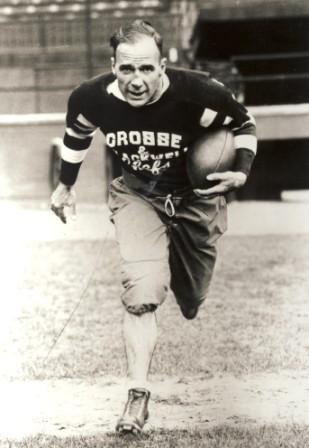
Lionel Pretoria Conacher, MP, nicknamed "The Big Train", was a Canadian athlete and politician. Voted the country's top athlete of the first half of the 20th century, he won championships in numerous sports. His first passion was Canadian football; he was a member of the 1921 Grey Cup champion Toronto Argonauts. He was a member of the Toronto Maple Leafs baseball team that won the International League championship in 1926. In hockey, he won a Memorial Cup in 1920, and the Stanley Cup twice: with the Chicago Black Hawks in 1934 and the Montreal Maroons in 1935. Additionally, he won wrestling, boxing and lacrosse championships during his playing career. He is one of three players, including Joe Miller and Carl Voss, to have their names engraved on both the Grey Cup and Stanley Cup.
The 1925–26 NHL season was the ninth season of the National Hockey League (NHL). The NHL dropped the Hamilton, Ontario team and added two new teams in the United States (US), the New York Americans and the Pittsburgh Pirates to bring the total number of teams to seven. The Ottawa Senators were the regular-season champion, but lost in the NHL playoff final to the Montreal Maroons. The Maroons then defeated the defending Stanley Cup champion Victoria Cougars of the newly renamed Western Hockey League three games to one in a best-of-five series to win their first Stanley Cup.
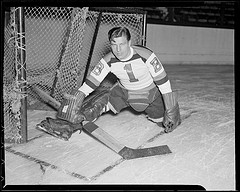
Francis Charles "Mr. Zero" Brimsek was an American professional ice hockey goaltender who played ten seasons in the National Hockey League (NHL) for the Boston Bruins and Chicago Black Hawks. He won the Calder Memorial Trophy as a rookie, and the Vezina Trophy twice, and he was named to the NHL All-Star team eight times. He was also a member of two Stanley Cup championships. At the time of his retirement in 1950, he held the records for most wins and shutouts recorded by an American goaltender; these records stood for 54 years and 61 years respectively. In 1966, he was inducted into the Hockey Hall of Fame, the first American goalie to be inducted; and in 1973, he was part of the inaugural class of the United States Hockey Hall of Fame. In 1998, Brimsek was ranked number 67 on The Hockey News' list of the 100 Greatest Hockey Players, the highest ranked American goaltender.

The Duquesne Gardens was the main sports arena located in Pittsburgh, Pennsylvania, during the first half of the 20th century. Built in 1890, the building originally served as a trolley barn, before becoming a multi-purpose arena. The Gardens opened three years after a fire destroyed the city's prior sports arena, the Schenley Park Casino, in 1896. Over the years, the Gardens was the home arena of several of Pittsburgh's historic sports teams, such as ice hockey's Pittsburgh Pirates and Pittsburgh Hornets. The Western Pennsylvania Hockey League, which was the first ice hockey league to openly hire and trade players, played all of its games at the Gardens. The arena was also the first hockey rink to ever use glass above the dasher boards. Developed locally by the Pittsburgh Plate Glass Company, Herculite glass was first tested in Pittsburgh. Most rinks were using wire mesh before the shatterproof glass was invented. Finally, the Pittsburgh Ironmen, a charter member of the Basketball Association of America, played at the Gardens from 1946 to 1947.

The Pittsburgh Hornets were a minor-league professional men's ice hockey team based in Pittsburgh, Pennsylvania.

Sports in Pittsburgh have been played dating back to the American Civil War. Baseball, hockey, and the first professional American football game had been played in the city by 1892. Pittsburgh was first known as the "City of Champions" when the Pittsburgh Pirates, Pittsburgh Panthers football team, and Pittsburgh Steelers won multiple championships in the 1970s. Today, the city has three major professional sports franchises, the Pirates, Steelers, and Penguins; while the University of Pittsburgh Panthers compete in a Division I Power Five conference, the highest level of collegiate athletics in the United States, in both football and basketball. Local universities Duquesne and Robert Morris also field Division I teams in men's and women's basketball and Division I FCS teams in football. Robert Morris also fields Division I men's and women's ice hockey teams.
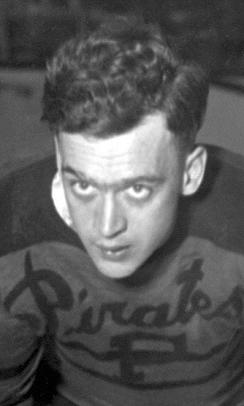
Wilfred Belmont "Tex" White was a Canadian professional ice hockey forward who played seven seasons in the National Hockey League for the Pittsburgh Pirates, New York Americans and Philadelphia Quakers between 1925 and 1931.
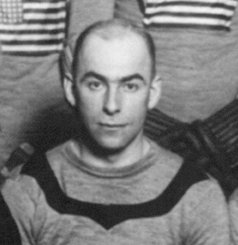
Herbert Joseph Drury was a Canadian-born American ice hockey defenseman who played six seasons in the National Hockey League for the Pittsburgh Pirates and Philadelphia Quakers. Internationally he played for the American national team at the 1920 Summer Olympics and 1924 Winter Olympics, winning a silver medal both times.
Pittsburgh Yellow Jackets was the name of three separate ice hockey teams based in Pittsburgh, Pennsylvania. The original team was part of the United States Amateur Hockey Association (USAHA) from 1920 to 1925 and developed from predecessors dating back to 1915. After winning the USAHA Championship in 1924 and 1925, the ostensibly amateur Yellow Jackets turned fully professional and became the Pittsburgh Pirates of the National Hockey League. After the Pirates relocated in 1930 to play as the Philadelphia Quakers, a second Pittsburgh Yellow Jackets club played for two seasons in the International Hockey League, a minor professional circuit. A third Yellow Jackets team was organized at the amateur level in 1935 by John H. Harris and competed in the Eastern Amateur Hockey League before folding in 1937.
The Pittsburgh Shamrocks were a professional ice hockey team, based in Pittsburgh, Pennsylvania that played in the International Hockey League in 1935–36. The team played all of its home games at Duquesne Garden. During their lone season in existence, the Shamrocks finished in fourth place in the West Division behind the Detroit Olympics, Cleveland Falcons, and Windsor Bulldogs. The Shamrocks scored 137 goals and allowed 170. The team folded after one season. It is estimated that the team lost $36,000 during 1935–36 season.
Francis Joseph "Frank, Duke" McCurry was a Canadian professional ice hockey left winger who played 145 games in the National Hockey League, with the Pittsburgh Pirates between 1925 and 1929.
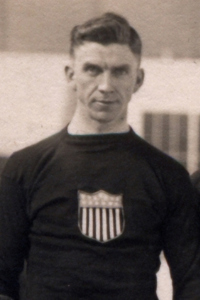
Joseph Wallace McCormick was a Canadian-born ice hockey player, from Buckingham, Quebec. Early in his career, during World War I, he played in Pittsburgh for the Duquesne Garden and Pittsburgh Athletic Association teams. In 1918, Joe enlisted in the U.S. Army. His older brother, Lawrence, followed his lead shortly afterwards. Joe served in the Army in France during the war. Because the brothers held an honorable discharge from the Army, they were entitled to automatic US citizenship and on March 17, 1920, just five weeks before playing in the 1920 Summer Olympics, they both became naturalized Americans.
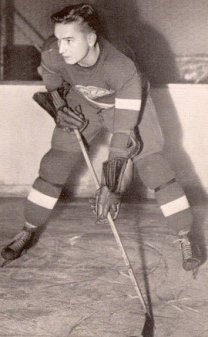
Roy George "Gus" Giesebrecht was a professional ice hockey centre who played 135 games in the National Hockey League with the Detroit Red Wings. During his career he accumulated 27 goals and 51 assists for a total 78 points. Giesebrecht was widely regarded by fellow players and NHL coaches as one of the most promising rookies in the league at the time. He scored a hat trick in the first period of the first game he saw on-ice action with the Red Wings, and scored the game-winning goal against the Chicago Black Hawks that advanced the Red Wings to the 1941 Stanley Cup Finals.
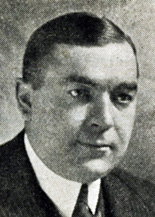
Roy Dunlap Schooley was a former hockey referee who later became the manager of both Duquesne Gardens, located in Pittsburgh, Pennsylvania, and the Pittsburgh Yellow Jackets of the United States Amateur Hockey Association. In 1925, the Yellow Jackets hockey club, evolved into the Pittsburgh Pirates of the National Hockey League. On March 16, 1920 at the Duquesne Gardens, he helped found USA Hockey, the governing body for amateur ice hockey in the United States. That same year, he assembled the first U.S. Olympic Hockey Team which won a silver medal at the 1920 Summer Olympics in Antwerp, Belgium and is credited with helping to foster the growth of hockey in the country.

Sylvester Patrick "Silver" Quilty was a Canadian football player, referee, coach and sport administrator. As a player, he won the Yates Cup in 1907 with the Ottawa Gee-Gees football team, and was credited as the first man to play the flying wing position. He also played with the Ottawa Rough Riders, and the McGill Redmen football team. After his playing career, he became a football referee and officiated the 10th Grey Cup, and also coached the Ottawa Rough Riders.
Robert Gessner is an American freelance artist, from Pittsburgh, Pennsylvania, who created many of the logos for the city's athletic teams. In addition to producing logos, Gessner also provided the artwork for the local teams' programs. After studying at the Art Institute of Pittsburgh, Duquesne University and the University of Pittsburgh, Gessner fought in the Korean War with the U.S. Army before returning to Pittsburgh to begin his freelance artist career. He is credited for providing logos to the Pittsburgh Penguins, Pittsburgh Pirates, Pittsburgh Hornets and the Pitt Panthers.

The United States Amateur Hockey Association (USAHA) was an ice hockey governing body in the United States from 1920 to 1925, which operated at an amateur level. The league was filled with predominantly Canadian-born players, but struggled to achieve consistent attendance figures in the days before large arenas with artificial ice. The association disbanded in 1925, with some teams eventually joining the American Hockey Association, and one team joining the National Hockey League.
The following is a timeline of the history of the city of Pittsburgh, Pennsylvania, US.
James Arthur Patrick Sullivan was a Canadian professional ice hockey player. He played with the Ottawa Senators of the National Hockey Association during the 1914–15 season.